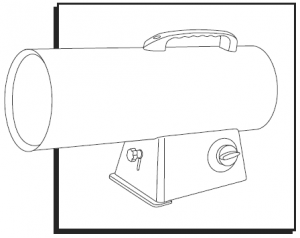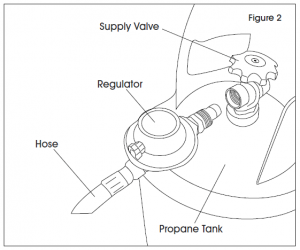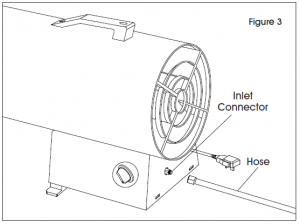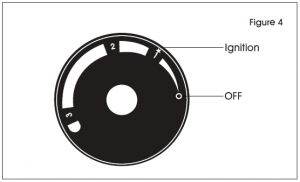Propane Heaters

H-6511, H-6512 PROPANE HEATERS1-800-295-5510uline.com
SAFETY WARNINGS
⚠️DANGER! Do not operate this heater until you have read and thoroughly understand the following safety and operating instructions.Failure to comply with the following precautions and instructions can result in death, serious bodily injury and property loss or damage from hazards of fire, explosion, burn, asphyxiation, carbon monoxide poisoning or electric shock.Only persons who can understand and follow the instructions should use or service this heater. If you need assistance or heater information, contact Uline Customer Service.⚠️WARNING! Fire, burn, inhalation and explosion hazard. Keep solid combustibles, such as building materials, paper or cardboard a safe distance away from the heater, as recommended in the following instructions. Never use the heater in spaces that contain volatile or airborne combustibles, or products such as gasoline, solvents, paint thinners, dust particles or unknown chemicals.⚠️WARNING! Not for home or recreational vehicle use.⚠️DANGER! Carbon monoxide hazard. This heater produces carbon monoxide, which has no odor. Burning the heater in an enclosed space can kill you. Never use the heater in enclosed spaces such as a tent, a camper, any vehicle or recreational vehicle (RV), enclosed shelter, or any other enclosed areas.
⚠️DANGER! If the information in this manual is not followed exactly, a fire or explosion may result causing property damage, personal injury or loss of life.⚠️DANGER! Not for use in residential living areas or in non-adequately ventilated enclosed spaces. Never bring or store a propane cylinder indoors.⚠️WARNING! This is an unvented portable heater. It uses oxygen from the surrounding area. Adequate combustion and ventilation air must be provided. See Ventilation on page 6.⚠️WARNING! This product contains chemicals, including lead, known to the state of California to cause birth defects or other reproductive harm. Wash hands after handling.This heater is designed and approved for use as a construction heater in accordance with ANSI Standard Z83.7-2011/CSA 2.14-2011. Check with your local fire safety authority if you have any questions about applications. Other standards govern the use of fuel gasses and heating products for specific uses. Your local authority can advise you about these.
SAFETY WARNINGS CONTINUED
⚠️WARNING! Risk of indoor air pollution.The products described in this manual are propane direct-fired, forced air heaters. Propane forced air heaters are primarily intended for use for temporary heating of buildings under construction, alteration or repair. Direct-fired means that all of the combustion products of the heater enter the heated space. This appliance is rated at 98% combustion efficiency, but does produce small amounts of carbon monoxide.⚠️DANGER! Carbon monoxide poisoning may lead to death.Carbon monoxide is toxic. Humans can only tolerate small amounts of carbon monoxide, so precautions must be taken to provide proper ventilation. Failure to provide proper ventilation in accordance with the following instructions can result in death.People with breathing problems should consult a physician before using this heater. Early signs of carbon monoxide poisoning resemble the flu. Symptoms of improper ventilation/carbon monoxide poisoning are headache, dizziness, nausea, dry mouth, sore throat and burning of nose and eyes.If you experience any of these symptoms, get fresh air at once. Have your heater serviced and check for proper ventilation. Some people are affected by carbon monoxide more than others. These include pregnant women, those with heart or lung problems, anemia or those under the influence of alcohol or at high altitudes.For outdoor use. Indoor use permitted only for temporary heating of adequately ventilated buildings or structures under construction, alteration or repair. Provide at least a three square foot opening of outside air for every 100,000 BTU/HR heater rating. Refer to Ventilation on page 6 for instructions.⚠️DANGER! Propane is an explosive gas.Do not attempt to light the heater.Extinguish any open flame.Shut off gas to heater.If odor continues, contact your local gas supplier or fire department.Do not touch or use any electric switch or any electric device that can cause a spark.Immediately call your gas supplier from a neighbor’s phone. Follow the gas supplier’s instructions.PAGE 2 OF 21
If you cannot reach your gas supplier, call the fire department.Service must be done by a qualified service agent.⚠️WARNING! Risk of burns, fire and explosion.Never store or use gasoline or other flammable vapors and liquids in the vicinity of this heater. Never store a propane cylinder not connected to this heater in the vicinity of this heater.Never connect heater to an unregulated gas supply.Never obstruct the flow of combustion and ventilation air (the front and rear of heater).Never use duct work in front or rear of heater.Never modify this heater or operate a heater that has been modified.Never service, move or handle heater while still hot or operating.⚠️WARNING! CAUTION! Hot while in operation. Do not touch. Keep children, animals, clothing and combustibles away from heater.Keep all combustible materials away from this heater.
|
MINIMUM CLEARANCE FROM COMBUSTIBLES |
|||
|
SIDES |
TOP |
FRONT |
REAR |
|
24″ |
36″ |
72″ |
24″ |
⚠️WARNING! Risk of electric shock.⚠️WARNING! Electrical grounding instructions: This appliance is equipped with a three-prong plug for your protection against shock hazard and should be plugged directly into a properly grounded, three-prong receptacle.Always use the electrical power (voltage and frequency) specified on the model plate of the heater.Always use only 14 AWG or better extension cord.Always unplug the heater when not in use.Always install the heater so that it is not directly exposed to water spray, rain, dripping water or wind.⚠️WARNING! For use with propane (LP) gas only.
SAFETY WARNINGS CONTINUED
- Use heater in accordance with all local codes.
- In the absence of local codes, refer to the National Fuel Code, ANSI Z223.1.
- This heater is shipped from the factory for use with propane (LP) gas only. Do not convert to any other gas. Installation must conform to local codes or with the standard for the Storage and Handling of Liquefied Petroleum Gases ANSI/NFPA 58 and the Natural Gas and Propane Installation Code CSA B149.1.
- Gas supply connections should be checked by using a 50/50 soap and water solution. Never use a flame to check for gas leaks.
- Locate LP cylinder at least 6 feet (10 ft. in Canada) from the heater. Do not direct heater discharge towards the LP cylinder unless it is at least 20 feet from the heater.
- Use only the regulator and hose assembly provided with this heater. Inspect the regulator/hose assembly prior to each use of the heater. If there is excessive abrasion or wear, or if the hose is cut, replace it with the proper assembly shown in the parts list prior to using the heater.
|
MINIMUM AND MAXIMUM INLET PRESSURE |
|
|
Min. |
5 PSI |
|
Max. |
Bottle Pressure |
⚠️WARNING! Risk of fire. Do not position heater in a downward angle. Always position heater on a stable and level surface. (See Figure 1)

UNPACKING
- Remove all packing items applied to heater for shipment. Keep plastic cover caps attached to inlet connector and hose/regulator assembly for storage.
- Remove all items from carton.
- Check all items for shipping damage. If the heater is damaged, promptly inform Uline Customer Service.
⚠️CAUTION! The propane gas (LP) pressure regulator and hose assembly supplied with the heater must be used without alteration.
SPECIFICATIONS
|
MODEL NO. |
H-6511 |
H-6512 |
|
BTU |
40k/50k/60,000 |
120k/135k/150,000 |
|
FUEL CONSUMPTION (LBS/HR) |
1.9/2.3/2.8 |
5.5/6.2/6.9 |
|
MAXIMUM OPERATING HOURS |
10.5 |
18 |
|
REQUIRED CYLINDER LBS |
20 |
100 |
|
FUEL TYPE |
Propane |
Propane |
|
HEATING AREA |
1,500 ft.2 |
3,800 ft.2 |
|
AIR FLOW (CFM) |
300 |
400 |
|
MAX. OUTLET TEMPERATURE |
491°F |
622°F |
|
VOLTS (AC/Hz) |
120V/60Hz |
120V/60Hz |
|
AMPS |
0.6A |
0.8A |
FEATURES

OPERATION
PROPANE SUPPLYPROPANEThis heater is not supplied with a propane cylinder. Use only an approved propane cylinder.LP CHARACTERISTICS
- Flammable, explosive under pressure, heavier than air and pools in low areas.
- In its natural state, propane has no odor, but for your safety, an odor that smells like rotten cabbage has been added.
- Contact of propane (LP) gas with the skin can cause freeze burns.
- Heater is manufactured for use with propane gas only. DO NOT attempt to convert to any other gas. Such modifications are dangerous and will void the warranty.
- When heater is not in use, LP cylinder must be turned off.
- Be sure that the LP cylinder is located on a level and stable surface.
- Do not use the heater in a basement or below ground level. Propane is heavier than air and will always seek the lowest level. If you suspect a leak, shut off the valve at the LP cylinder immediately.The propane (LP) cylinder must be equipped with the following:
- A collar to protect the gas valve.
- A shut-off valve terminating an LP cylinder valve outlet as specified in the American National Standard for Compressed Gas Cylinder Valve Outlet and Inlet Connections.
- A safety relief valve having direct communications with the vapor space of the LP cylinder.
- The heater must operate on vapor withdrawal from the operating cylinder.
The amount of propane (LP) used with this heater varies due to:
- The amount of gas in the cylinder of LP.
- The temperature of the LP tank and its surroundings.
The table below shows the minimum number of 100 lb. LP cylinders required in cold weather. Your local LP dealer will help you select the proper LP supply system.
|
AVERAGE TEMP |
H-6511 20/100 LB. CYLINDER |
H-6512 20/100 LB. CYLINDER |
|
32°F |
1 |
2 |
|
20°F |
1 |
2 |
|
10°F |
1 |
3 |
|
0°F |
1 |
3 |
|
-10°F |
2 |
Use Larger Tank |
|
-20°F |
2 |
Use Large Tank |
⚠️CAUTION! Propane is safe to use when properly handled. Careless handling of the LP cylinder could result in a fire or explosion.
- Always keep LP cylinder fastened and upright.
- Avoid tipping the LP cylinder on its side when connected to a regulator, since this may cause damage to diaphragm in the regulator.
- Handle valves with care.
- Never connect an unregulated LP cylinder to a heater.
- Do not subject LP cylinder to excessive heat.
- Tightly close the gas shutoff valve on the LP cylinder after each use.
- All fittings must be protected when disconnected from the LP cylinder.
- Never store an LP cylinder inside a building or in the vicinity of any gas burning appliances.
⚠️CAUTION! The disconnected tank must never be stored in a building, garage or any other enclosed area.
OPERATION CONTINUED
PREPARATIONCONNECTING THE LP CYLINDER⚠️WARNING! Purging and filling LP cylinders must be performed by personnel who have been thoroughly trained in accepted LP gas industry procedures. Failure to follow these instructions may result in explosion, fire, severe personal injury or death.☞ NOTE: All new LP cylinders must be purged before the first filling.
- Turn heater gas valve knob and LP cylinder valve to OFF position.
- LP cylinder valve equipped with old style fitting has left handed threads. Turn fitting clockwise to loosen. Protect this fitting when disconnected from LP cylinder.
- Have your LP cylinder filled by your local propane gas supplier.
- Some LP cylinders have a bleed-off valve. This valve should be inspected for leaks after each filling of the LP cylinder. Turn the valve clockwise to close.
- Fasten full propane tank and connect proper fitting to LP cylinder valve by turning counterclockwise.
- With heater gas valve knob still in off position, turn on the LP cylinder valve and check for leaks with soap solution.
CHECKING FOR LEAKS
- To check for leaks, make up a 50/50 solution of dish soap and water. Apply this solution to all gas connections. If bubbles appear, there is a leak.☞ NOTE: If a leak is found, turn off the gas supply, and reconnect the leaking connection. If the leak persists after several tries, contact Uline Customer Service at 1-800-295-5510.☞ NOTE: The installation of this heater must meet all local codes and/or gas utility requirements. In the absence of local codes, the National Fuel Code ANSI Z223.1 should be followed.☞ NOTE: The minimum clearances to any combustible construction materials must be maintained at all times. (See Minimum Clearance from Combustibles on page 2)
- Inspect the heater before each use, and at least annually by a qualified service person.
LIGHTING INSTRUCTIONSIGNITING THE HEATER
- Connect the heater to a properly grounded, three prong power source. You must use a three prong extension cord that is at least 6 feet long is a minimum of 14 AWG rating.
- Connect heater to a proper LP cylinder. (See Figures 2 and 3)


- Turn gas valve clockwise to off position.
- Wait five minutes for any glass to clear. Smell for gas, if you do not smell gas, go to step 5.
- Push in and turn gas control knob counterclockwise to 1 position. This will light the burner. If needed, keep pressing control knob until the burner lights and keep pressing and turning from “O” (OFF) to 1. (See Figure 4)

- Keep the valve knob depressed for at least 30 seconds after lighting the burner. After 30 seconds, release the valve knob.
- If the burner does not stay lit, repeat the lighting procedures.
- When burner stays lit, turn gas valve knob counterclockwise to desired setting.
SHUTDOWN THE HEATER
- Turn gas valve knob clockwise to “O” position. (See Figure 4)
- Turn gas supply OFF by turning the LP cylinder valve clockwise to close.
- Disconnect the power cord.
TEST FIRING THE HEATER
- Test fire your heater following the lighting instructions applicable to the gas control system employed.
- Leak test all gas connections with 50/50 soap and water solution prior to start-up. Soap bubbles indicate a gas leak. DO NOT use a match or flame to test for gas leaks.NOTE: Heater surface temperature must be cold before initiating service, cleaning or storage.
VENTILATION
⚠️DANGER! Carbon monoxide poisoning may lead to death.
- Risk of indoor air pollution and carbon monoxide poisoning. Use heater only in well ventilated areas.
- Refer to Safety Warnings on pages 1-3 for information about carbon monoxide poisoning.
- Always provide a fresh air opening in the heated space of at least three square feet for each 100,000 BTU/HR of heater output. Provide a larger opening if more heaters are being used.
MINIMUM VENTILATION OPENING NEEDED
H-6511 – H-65121.8 ft.2 – 4.5 ft.2
⚠️DANGER! Not for use in residential living areas or in enclosed spaces that are not adequately ventilated.
STORAGE AND MAINTENANCE
Always disconnect the heater from the LP cylinder before putting the heater into storage. If for any reason the heater is to be stored indoors, the tank must be disconnected from the LP cylinder and the cylinder stored outdoors in a well-ventilated area, out of the reach of children, and in accordance with the Standard for Storage and Handling of Petroleum Gases, ANSI/NFPA 58 latest edition and Natural Gas and Propane Installation Code, CSA B149.1. The plastic valve plug or valve cover supplied with the cylinder must be reinstalled on the valve to protect the fitting from damage.
⚠️DANGER! Never store an LP cylinder inside of a building or near any other gas or oil burning appliances.NOTE: Installation and repair of this heater should be done by a qualified service person.Always be sure to follow proper maintenance procedures. This should include cleaning the inside of the heater once a month and checking the spark gap at least once a heating season. Re-gap the terminals to 0.160″.
WIRING DIAGRAM

TROUBLESHOOTING
LOCATING YOUR SERIAL NUMBERYour serial number can be found on a white label on the right side cover of your heater. It will begin with the letters “HGF” followed by eight digits. For example, HGF12345678.
| OPERATING ISSUE | CAUSE |
RECOMMENDATIONS
|
| Fan does not turn when electricity is connected. | No electric power to heater.Blades of fan in contact with heater housing. Fan blades bent. Fan motor defective. |
Check current at outlet. If voltage is correct, inspect extension and power cords for cuts, frays or breaks Check housing for damage. Be sure there are no dents in the housing obstructing the fan. Straighten all fan blades. Replace motor assembly.
|
| Heater will not fire (ignite). | No spark at module.Incorrect spark gap. Corroded electrode. |
Inspect module wire. Re-attach or tighten if loose. Inspect spark module and replace if necessary. Inspect all other electrical components. Set plug gap to 0.16″. Replace spark plug (multi-bracket assembly).
|
| Heater stops running by itself. | Temperature inside heater is too high, causing thermal switch to shut down operation. Damaged control valve. Dust or debris accumulated in heater. |
If the heater input or output is restricted, the inside temperature can become too hot. Keep the areas in front and behind heater clear of obstructions. Replace control valve. Clean inside of heater.
|
[xyz-ips snippet=”download-snippet”]




